This is a preprint.
Productive mRNA Chromatin Escape is Promoted by PRMT5 Methylation of SNRPB
- PMID: 39149374
- PMCID: PMC11326253
- DOI: 10.1101/2024.08.09.607355
Productive mRNA Chromatin Escape is Promoted by PRMT5 Methylation of SNRPB
Update in
-
Productive mRNA chromatin escape is promoted by PRMT5 activity.Mol Cell. 2025 Nov 6;85(21):4016-4031.e9. doi: 10.1016/j.molcel.2025.09.021. Epub 2025 Oct 13. Mol Cell. 2025. PMID: 41086806
Abstract
Protein Arginine Methyltransferase 5 (PRMT5) regulates RNA splicing and transcription by symmetric dimethylation of arginine residues (Rme2s/SDMA) in many RNA binding proteins. However, the mechanism by which PRMT5 couples splicing to transcriptional output is unknown. Here, we demonstrate that a major function of PRMT5 activity is to promote chromatin escape of a novel, large class of mRNAs that we term Genomically Retained Incompletely Processed Polyadenylated Transcripts (GRIPPs). Using nascent and total transcriptomics, spike-in controlled fractionated cell transcriptomics, and total and fractionated cell proteomics, we show that PRMT5 inhibition and knockdown of the PRMT5 SNRP (Sm protein) adapter protein pICln (CLNS1A) -but not type I PRMT inhibition-leads to gross detention of mRNA, SNRPB, and SNRPD3 proteins on chromatin. Compared to most transcripts, these chromatin-trapped polyadenylated RNA transcripts have more introns, are spliced slower, and are enriched in detained introns. Using a combination of PRMT5 inhibition and inducible isogenic wildtype and arginine-mutant SNRPB, we show that arginine methylation of these snRNPs is critical for mediating their homeostatic chromatin and RNA interactions. Overall, we conclude that a major role for PRMT5 is in controlling transcript processing and splicing completion to promote chromatin escape and subsequent nuclear export.
Keywords: Arginine Methylation; Arginine Methyltransferase; PRMT1; PRMT5; Post-Translational Modifications; Splicing; Transcription; mRNA Processing.
Conflict of interest statement
Conflict of Interest The authors declare that they have no conflicts of interest with the contents of this article. The content is solely the responsibility of the authors and does not necessarily represent the official views of the National Institutes of Health. J.B. was an employee of Arpeggio Bio, and J.A. is an employee and founder of Arpeggio Bio, which was contracted to undertake the PRO-seq experiments described in this paper.
Figures







References
-
- Maron M.I., Lehman S.M., Gayatri S., DeAngelo J.D., Hegde S., Lorton B.M., Sun Y., Bai D.L., Sidoli S., Gupta V., et al. (2021). Independent transcriptomic and proteomic regulation by type I and II protein arginine methyltransferases. iScience 24, 102971. 10.1016/j.isci.2021.102971. - DOI - PMC - PubMed
-
- Friesen W.J., Paushkin S., Wyce A., Massenet S., Pesiridis G.S., Van Duyne G., Rappsilber J., Mann M., and Dreyfuss G. (2001). The methylosome, a 20S complex containing JBP1 and pICln, produces dimethylarginine-modified Sm proteins. Mol Cell Biol 21, 8289–8300. 10.1128/MCB.21.24.8289-8300.2001. - DOI - PMC - PubMed
Publication types
Grants and funding
LinkOut - more resources
Full Text Sources
Miscellaneous
